Susan Abele
.png?ver=2019-06-01-064009-903)
Figure 1. Red-headed Woodpecker at my feeder. Photograph by Carol Molander, June 13, 2018.
Immediately upon landing in America, at Newcastle, Delaware, July 14th, 1794, (Wilson) …shot the first bird that presented itself, a Red headed Woodpecker, and he thought it the most beautiful bird he had ever beheld. (Burns 1908)
Red-headed Woodpeckers in the Neighborhood
It is not every day that one staggers out of bed at 6:30 am, and peering out the window, lays eyes for the first time on a glorious adult-plumaged Red-headed Woodpecker, Melanerpes erythrocephalus! No different from Alexander Wilson and many others enchanted by this bird, I was dazzled and in my excitement whipped off an email to Trevor Lloyd-Evans at nearby Manomet, known to me from its inception as the Manomet Bird Observatory. Trevor responded, cautious but affirming, and several hours later showed up on my doorstep. An afternoon of generous conversation was rewarded with a late day visit from the bird I learned to call an RHWO.
On that July day in 2017, I could not foresee the remarkable opportunity that would present itself when a Red-headed Woodpecker, possibly the same bird, showed up on May 10, 2018, one day after I returned to my summer home in Plymouth and put out seed and suet feeders. By summer’s end, several other observers and I documented this woodpecker and its mate as they successfully raised their young—the first confirmed breeding pair in Massachusetts in decades.
In 1927, Edward Howe Forbush reported a handful Red-headed Woodpeckers— summer and winter—in Plymouth, Bristol, and Barnstable counties, and one nest on the outer arm of Cape Cod. Manomet banded a hatch-year (HY) bird on September 10, 1973. Mass Audubon’s first Massachusetts Breeding Bird Atlas (Petersen and Meservey 2003) confirmed one nest in all of Massachusetts. None were confirmed in Massachusetts Breeding Bird Atlas 2 (Walsh and Petersen 2011). On October 10, 2011, Wayne Petersen photographed a juvenile Red-headed Woodpecker in Middleboro and reported to Bird Observer that the birds are “rare to very uncommon migrants in Massachusetts” and that they are most likely to be encountered in September and October, or else found wintering at birdfeeders almost anywhere in the state (Petersen 2011). Since then, eBird records have cited a small number of immature and adult birds in eastern Massachusetts—again summer and winter—but no confirmed nest sites, thus substantiating the rarity of the bird that first captured our attention in 2017.
Manomet’s Lisa Schibley made the first Red-headed Woodpecker report to eBird in 2018, beginning our rewarding mutual endeavor. With deep appreciation for the amazing opportunity and with the help of many dedicated eBirders who photographed the birds’ activities, we documented the successful nesting of a pair of Red-headed Woodpeckers, later known to some as Smudge, because of yellow-stained wing feathers, and Pudge because it rhymes with smudge. At that time, even with this distinguishing feature, we were unable to assess by behavior whether the sexually monomorphic bird was male or female.
Field Notes
Careful observations and field notes, supplemented with photographs by eBirders verify the Red-headed Woodpecker’s activities, actions that in turn are verified in the literature (see the section below of the History of Red-headed Woodpeckers in Massachusetts). The following excerpts from my field notes, along with additional comments, structure the time line for the Red-headed Woodpecker pair nesting in Plymouth in 2018.
July-August 2017: For about five weeks, beginning on July 17, a Red-headed Woodpecker, calling each time, came to suet feeders at 184 Manomet Avenue in the Manomet section of Plymouth. Red-bellied Woodpeckers were also in the area. I learned to distinguish between the calls of the two birds, and thus was alerted when the RHWO was in the area. Often, the bird seemed skittish, sometimes lighting on the feeder, but taking off again without taking any suet.
May 10, 2018: I set out feeders yesterday upon my arrival for the summer and today the RHWO “returned.” I like to think it was the same bird. (See Figure 1.) May 24: Because the bird usually flew in and out of the yard from the same direction, Lisa Schibley searched south along Manomet Avenue toward Brewster Avenue, where she found the RHWO roosting in a stand of Norway spruce. She posted to eBird: “Seen 3 times over two hours. No pictures but got a recording. Perfect adult. Full red head. Black wings with white secondaries.
June: Throughout the month, I saw the RHWO at my feeder.
June 10: Visits to my feeders seemed to increase.
June 12: Between 6:00 and 7:00 pm, a bird came to the feeders at least seven times, flying in and out from different directions, several times in such quick succession that I began to think that there might be more than one bird. While watching Red-bellied Woodpeckers feeding their young, I had a split-second view of two RHWOs chasing each other in the treetops west of 184 Manomet Avenue.
June 17: The area of observation widened to a wooded area behind my house. David Clapp and Ian Davies reported “**continuing adult; calling and seen flying along Circuit Avenue.”
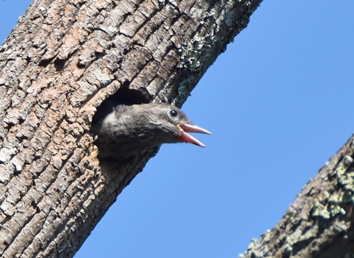
Figure 2. First nestling to fledge. Photograph by Austin Mason, August 29, 2018.
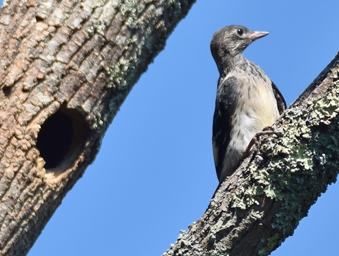
Figure 3. First fledging perches on a branch. Photograph by Austin Mason, August 29, 2018.
June 25: Bob Stymeist reported a “continuing male” at the end of Circuit Avenue at Holmes Road. By late June, other eBirders reported sightings on a dead maple tree near the intersection of Circuit Avenue and Holmes Road.
June 26: Family members reported a brief sighting of two birds chasing around the tree near one of the suet feeders in my yard at 184 Manomet Avenue.
June 27: Marshall Iliff posted “**rare; continuing adult on snag among white pine, pitch pine and spruce; calling, drumming, and inspecting cavities. Breeding Code S7 Male present 7 + days (Probable).”
July 12: Marshall Iliff again posted the presence of a male bird, probably breeding. Iliff noted that as soon as he arrived, the bird was easily found perched on the snag at the side of Holmes Road.
July 24-25: The RHWOs abandoned the suet feeders and were not seen again in my yard.
August 1: I walked along Circuit Avenue to Holmes Road and for the first time observed two adult birds on the maple snag. With permission, I walked onto the property at 9 Holmes Road and saw the nest cavity in the bare upper branches of the snag. For more than an hour, I observed the birds returning again and again to the nest cavity and sent triumphant emails to Trevor.
August 15: Lisa documented the feeding activity and made an audio recording of nestlings responding to the parents’ approach. She also documented nest cleaning.
August 18: Lisa reported, “Two parents visiting nest site with food. Nestlings heard faintly… Breeding Code: ON Occupied Nest (confirmed).”
August 23: Lisa photographed two adult birds at the nest and a woodpecker head in the nest cavity and posted to eBird: “Most likely more than one baby…Lots of noise when the parents approach the nest.” Based on observational data from the feeder site, we figured that the babies would fledge during the week of August 27–31.
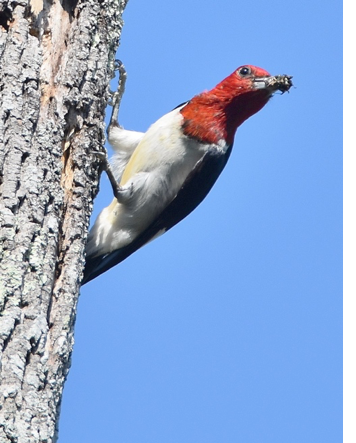
Figure 4. Adult bird brings insects to the nestlings. Photograph by Austin Mason, August 29, 2018.
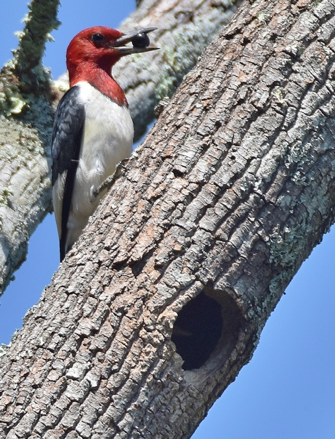
Figure 5. Adult bird also feeds fruit to its young. Photograph by Austin Mason, August 29, 2018.
August 24: Observed a hummingbird circling about the RHWO roosting at the top of the tree. This happened more than once. Was that bird attracted to the red head of the woodpecker?
August 29: Austin Mason photographed the first baby to poke its head out; several seconds later, the fledgling perched on the branch. (See Figures 2 and 3). We watch the adults feed insects and fruit to the babies. (See Figures 4 and 5.)
August 29: Lisa reported “one young fledged. Two seen still in the hole.” With the second baby out of the nest, we observed two more babies. One fledged unobserved the same day; also unseen, the third fledged two days later.
August 30: I began watch about 8 am. Linda Fuller and I observed the third baby being fed by two adults, Smudge with the stained feathers, and Pudge, because it rhymed with Smudge. Baby number three sometimes poked its head out, looked around, and then retreated inside the nest. The parents began to re-enter nest cavity, disappearing out of sight as they did when babies were smaller, a change from the most recent behavior. In the late afternoon, I returned to the site with Trevor and saw the last baby, still in the nest cavity.
August 31: I spent a long morning watching and returned briefly to site in the afternoon, but did not see the baby. The adults continued to attend to nest cavity however, but their pattern of behavior was very different. The RHWO would pause for an extended time at the outside the nest and occasionally re-entered the cavity. It was tempting to wonder if there was a fourth baby that was failing to thrive. Attendance on the nest cavity diminished over time.
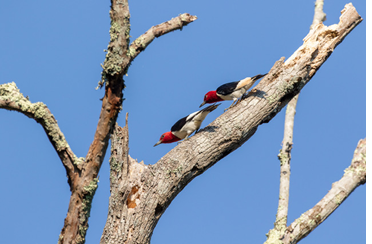
Figure 6. "Sexual pose" described by Kilham. Photograph by Linda Fuller, September 6, 2018.
September: The birds remained in the vicinity of the nest tree for most of the month of September. I continued daily visits but of shorter duration.
September 4: From 4:30 to 5:15, I observed the two adult birds fly catching from the nest tree.
September 5: Lisa and I were in the field at mid-day. While I kept an eye on one baby on the nest tree, Lisa spotted the two others together in the canopy of an oak tree. Three babies accounted for.
September 6–9: The birds continued to return to the roost tree. The adult birds would routinely perch at the top of the main trunk, which was also their “anvil” site. The adult birds, whether Smudge or Pudge was not recorded, continued to hang outside the nest cavity for minutes at a time, appearing to look or listen, and occasionally entering the hole and disappearing from sight.
Staining on Smudge’s feathers was probably acquired during brooding inside the nest cavity. The male bird broods at night, but since both birds share incubation, male versus female behavior could not be determined except in Figure 6, showing the “male and female Red-headed Woodpeckers in sexual pose” (Kilham 1977). Smudge, the presumed male with the stained feathers, is on the right. Copulation did not occur, or at the least was not observed, and there was no evidence of a second brood.
September 11: Late afternoon, I saw the two adults fly catching, along with at least two of the three babies. At times, the babies hung out in the tallest Norway spruce tree on Circuit Avenue, and in the oak trees in the yard at 9 Holmes Road.
September 13: Lisa posted to eBird: “Susan and I saw the two adults and three young still hanging in the area around the tree...about 30–40 minutes between visits from the family...all 5 seen at once.”
September 14: The babies began to be more active, investigating the nest cavity. (Figure 7).
September 15: I staked out the snag for the Manomet Bird-a-thon crew. About 11:15, a dark gray CRV came to a quick stop near the tree, the doors burst open and out came members of the South Shore Bird Club team, binoculars at the ready! Lisa’s post to eBird: “One adult one young for Manomet Birdathon (sic) on the Red-headed Woodpecker Tree, Plymouth, Massachusetts.”
September 21: I discovered that the nest cavity had been raided. The lower edge was ripped away, the wood fibers shredded by what appeared to be a ripping motion. Raccoons? I saw some little footprints at the edge of a nearby mud puddle on the road. Despite destruction of the nest cavity, the RHWOs were still active on the roost tree.
September 22: Lisa commented on eBird: “All still traveling in a family group. Watched one adult fly off chased by two young’uns then saw the second adult feeding the third juvie. Were seen just south of the Circuit St. & Holmes Rd. intersection and flew off toward Samoset and not seen again at a 20-minute wait by the original nest tree.”
September 27: The birds were last seen by Lisa, Pete Jacobson, and me. Lisa and Pete saw two juveniles on nearby Samoset Avenue. I saw one juvenile in treetops on Holmes Road. Unlike RBWOs and DOWOs, who brought in the their babies, Smudge and Pudge never returned to the feeders at 184 Manomet Avenue.
February 3, 2019: John Galluzo reported a juvenile in Pembroke Woods, only 20 miles from Manomet. (eBird 02-03-19)
Other observations
Territory and Conflicts
As late as 2000, Red-bellied Woodpeckers, like Red-headeds, were “rare vagrants in Massachusetts.” Today Red-bellieds are common in “open second-growth woods” and are year-round residents in Manomet (Walsh and Petersen 2013). Jerome A. Jackson confirmed the Red-headed Woodpecker and the Red-bellied Woodpecker as “congeners,” finding many similarities in breeding, incubating, and brooding behaviors.
The Red-headed Woodpecker breeds later in the season, however, preferring to nest in open areas, while the Red-bellied Woodpecker breeds earlier and chooses a more wooded site. Jackson suggested that migratory versus nonmigratory habits are likely factors that allow these two species to live in overlapping areas (Jackson 1976). I observed no conflicts between these birds; they both bred successfully in my Manomet neighborhood. Territorial conflicts between Starlings and Red-bellieds are common, but there were no Starlings in the neighborhood. Resident crows occasionally perched on the roost tree, but the woodpeckers did not chase them away. Late in the season, Red-breasted Nuthatches circled the roost tree, but were chased off. An unseen marauder raided the nest three weeks after babies fledged, but until that point, we did not observe any serious interference with the original nest cavity.
Nesting and Foraging
Almost every time I walked to the nest site on Holmes Road during the month of August, one of the woodpeckers was roosting at the top of the main trunk of the maple snag, suggesting the importance of the roost tree. Coues (1883) noted that Red-headed Woodpeckers located seemingly on a whim, and that the birds were equally at home in “garden and park as in the depths of the woods….” Seed and suet feeders attracted the birds to my yard, which opened to what might be called a park-like area on the Manomet bluffs. For their nest site, the birds found a snag standing in the midst of a wooded area of oak, pitch pine, and spruce a few hundred feet to the west of my house. The snag sheltered the nest cavity and became a launch site for fly catching. The top of the main trunk of the snag was also the “anvil” site. When the birds brought in large insects, they would perch at the flat top of that trunk and pound on their prey before caching or feeding to nestlings—typical behavior described by Kilham (1988). In addition, the two adults worked up and down the main trunk, which I began to call the larder, gleaning invertebrate material.
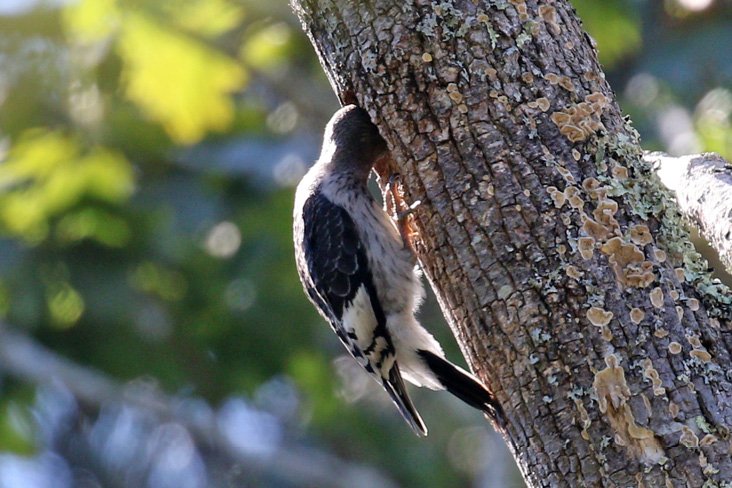
Figure 7. Juvenile inspects the nest cavity. Photograph by Steven Whitbread, September 14, 2018.
An observer in Kansas noted that during the breeding season, Red-headed Woodpeckers foraged extensively by fly catching and stooping (Jackson 1976). I observed stooping—flying to the ground to capture prey—in early July in my yard, but not in the vicinity of the nest site. One study quantified the summer diet for the Redheaded Woodpecker as “34% animal (mainly insects) and 66% plant material” (Frei et al. 2017). Percentages must certainly vary according to availability, but insects and wild fruits were sufficiently plentiful to support this family of Red-headed Woodpeckers in 2018. Curiously, the adults stopped coming to my suet feeder after June 25, which would have been shortly before the babies hatched (working backwards from the August 29 fledging date. Unlike the juvenile Downy and Red-bellied woodpeckers, the young Red-headed Woodpeckers never came to suet feeders.
Fledging
Red-headed Woodpeckers lay an average of four to seven eggs, which they incubate for 12–14 days. They lay their eggs over a period of several days and hatching is asynchronous. The babies remain in the nest from 24 to 31 days (Frei et al. 2017). The Manomet woodpeckers nested late in the season and successfully fledged three young. They stayed together as a family group for about a month before disappearing.
Once out of the nest, the fledglings sheltered in the upper branches of a tall Norway spruce and in the oaks adjacent to the roost tree. We observed them, often stationary on the roost tree, being fed by the parents. As time went on, they began to glean as well as investigate other cavities on the tree. Fly catching by the adults continued and later the young followed suit.
The many hours spent in the field observing the Red-headed Woodpeckers’ feeding habits were rewarded with a demonstration by the most persistent fly catcher in the woodpecker family—shown in the word picture below. At the end of the afternoon on September 11, with the sun lowering in the west, there must have been a hatch or bloom of flying insects, invisible to my eye, but not to Smudge and Pudge, who put on a captivating display—soaring, twisting, snatching— returning to the roost only to become airborne again in pursuit of the winged creatures that I could not see. Stunning flashes of white from their wings, and the glint of red touched by the setting sun was magical. The young birds, handsome in their own right and less than 10 days out of the nest, showed off their skills. Although not as adept as their parents—their flights were shorter—they added to my delight…birds in an airborne dance to a rhythm of their own making.
History of Red-headed Woodpeckers in Massachusetts
Fascinated by these birds and with Alexander Wilson in mind, I began to research the history of the Red-headed Woodpecker in nineteenth-century literature penned by Massachusetts naturalists and ornithologists. The first state report on “Fishes, Reptiles and Birds,” authorized by the Massachusetts Legislature and written by Unitarian minister William Bourne Oliver Peabody, was published in 1839. Enumerating some 240 species, he declared that the “Red-headed Woodpecker, Picus erythrocephalus, is a very elegant bird, and perhaps the most common of this familiar race.”
The first objective of the 1839 state report was to “enumerate the birds of Massachusetts.” The second was to gather information respecting their habits, “particularly such as cultivators are interested to know.” With remarkable forethought, Peabody rejected the idea of destroying birds and suggested, “In every instance of our removing a present inconvenience, we are opening a door for the entrance of much greater evils.” Peabody also suggested that killing birds by those who “wish to secure their orchards,” only satisfied a need for revenge. He went on to rail against “wanton boys…permitted to indulge in a cruel amusement, from which every man of sense and feeling should carefully withhold his children.”
Peabody also explained that while the Red-headed Woodpecker “occasionally regales himself on fruit… his natural and most useful food is insects.” He noted that the birds’ feeding habits could be seen as an important control on the insect population. He did not concede that the collection of skins might also be a concern (Peabody 1839).
Edward Samuels (1870), quoting from Wilson’s American Ornithology, described flocks of Red-headed Woodpeckers and damage to fruit crops, which led to bounties being levied and farmers shooting the birds. “No other species of woodpecker in U.S., with possible exception of the Yellow-bellied Sapsucker…was the subject of so much adverse criticism during nineteenth century as an agricultural pest” (Frei et al. 2017).
Eliot Coues, a founding member (with William Brewster and others) of the American Ornithologists’ Union (AOU), commented that persecution of this “conspicuous apparition” may affect its survival, “for certainly all persons with gun in hand, on their collecting tours, cannot resist the temptations of a shot at the beautiful creature, and the bird itself is one which never seems to profit by the lesson of danger notoriety teaches” (Coues 1883). William Brewster noted the irregular occurrence of Red-headed Woodpeckers at all seasons, and that the “greatest influx that has taken place within my personal recollection occurred in the autumn of 1881 when, for three of four weeks, Red-headed Woodpeckers literally swarmed about Cambridge and Boston.”
Brewster noted that the earliest breeding record from a Nuttall Ornithological Club Bulletin, “in the immediate neighborhood of Boston appears to be that by Mr. Purdie of a nest containing five eggs which was found by Mr. H. K. Job in June, 1878, in a hole of an apple tree in Brookline” (Purdie, 1882). Nesting records remained sparse, however, and in 1889 observers described a nest in Agawam as the last one known in the state (Howe and Allen 1901). One might question the validity of this statement, but suffice to say that there were no other published records until after the turn of the twentieth century.
Brewster (1906) described a pair of Red-headed Woodpeckers nesting in a grove of large chestnut trees not far from Waverly station in Belmont, which caught my attention because Charles Johnson Maynard (1909) recorded a nesting pair at Waverly in 1909.
Ambitious, independent, and not always in sync with the elite members of the Nuttall Ornithological Club (founded in Cambridge in 1873), Maynard emerged at the turn-of-the-century as a widely respected teacher. After his death, critics would recognize him as an “erratic genius” (Abele 2002). C. J. Maynard, as he styled himself, began as a naturalist and collector, writing his first book The Naturalist’s Guide in 1870. Drawing on work by Allen, Coues, and others, he compiled a species list of Massachusetts birds including, “#131. Melanerpes erythrocephalus, Swain.— Exceedingly rare…perhaps accidental. I have never seen it living. One seen by Mr. W. Brewster, in summer, at Waltham” (Maynard 1870). In his ambitious Birds of Eastern North America (Maynard 1889), self-published with illustrations by his own hand “drawn on stone,” he supplied a concordance updating names according to the new AOC check list: “Melanerpes erythrocephalus, Linnaeus.”
Maynard began conducting bird walks in 1893, and from 1908 to 1920 published a serial record of weekly nature classes, listing birds seen on walks in the greater Boston area, southeastern Massachusetts, Ipswich, and Plum Island. The weekly booklets were sold by subscription and compiled yearly as Records of Walks and Talk with Nature. In Volume 2, there were three records for the Red-headed Woodpecker, including the nest site at the Waverley Station in Belmont. At this time, when sight records were not always credited, Maynard asserted that
the information given…has always been fresh and as far as editorial judgement…reliable; nothing which seemed questionable having been allowed a place in its pages. Most of the notes published have at best been only a few days old, and frequently that have appeared in a few hours. (Maynard 1909)
After compiling the first year’s work, Maynard voiced pride in what he had accomplished, suggesting that the work was “unique among publications devote wholly to Nature Study, at least in America” and envisioning that the records would “flow onward like water and finally contribute their portion to that great ocean of scientific research that belts the globe” (Maynard 1908). Maynard was held in high regard by his students and on his 65th birthday, more than 200 individuals, “including his old friend William Brewster,” presented him with Zeiss binoculars (Griscom 1955).
Edward Howe Forbush became state ornithologist in 1908, the same year Maynard began to publish Walks and Talks with Nature. Forbush began as a shotgun collector, and as a young man studied taxidermy with Maynard. He described the Red-headed Woodpecker in the second volume of his three-volume work, the Birds of Massachusetts and other New England States, as a “Rare, Irregular visitor at all seasons…(that) may be seen casually at any season, but apparently not as permanent residents” (Forbush 1927). He also published the first comprehensive range map showing Red-headed Woodpecker nest sites in Massachusetts.
About twenty years later, Griscom (1955) published a checklist of birds found on Plum Island, noting that the total at that time stood at 320 species and subspecies, and suggested that the list was “one of the most remarkable local lists ever made in the Northeastern States.” Included on the list, was the Red-headed Woodpecker: “Rare casual. October 17, 18, 1938 (Safford); October 3, 4, 1953 (Emery, Beatties).” This was a fitting entry, because the Red-headed Woodpecker was among the first birds that Griscom learned to identify early in his career (Davis 1994).
Griscom—who noted that Maynard was ahead of his time listing sight records, which “played a major role in the early twentieth century shift from the ‘shotgun’ to ‘binocular’ school of ornithology”— according to Davis (1994) was responsible, “more than any other single individual, for the development of the technique of rapid identification of birds.” The ever-expanding community of birdwatchers that followed Maynard and Griscom forged a solid link to the citizen scientists of eBird and the documentary images in this article, shot with a camera instead of a gun.
Supporting my fascination for the Red-headed Woodpecker, Trevor pointed me to Kilham’s (1983) Woodpeckers of Eastern North America, first published by the Nuttall Ornithological Club. In a later book, On Watching Birds, Killam (1988) generously suggested, “that watching birds…can be more than just a scientific exercise and that watching first…making one’s own discoveries opens the mind.” Kilham’s landmark study of woodpeckers began in just such a manner, suggested to him by his first encounters in 1956 with a flock of the charismatic Red-headed Woodpecker near his home in Maryland (Kilham 1988).
The joy of insight is astounding, each source that I read providing ah-ha moments and recognized behaviors. Bent’s (1992) Life Histories of North American Woodpeckers, also read by Kilham, covers a great range of descriptive literature pertaining to the Red-headed Woodpecker in the Northeast, the Midwest, and the southern coastal states. In southeastern Massachusetts, he said that he had only seen one Red-headed Woodpecker in fifty years of field work, and that he had to chase it “across the line from Rhode Island’ in order to shoot it (Bent 1992). Scholarly articles by Kilham and Jackson provide specific scientific descriptions about sexual identification, nesting and breeding behavior, and the particular skills of fly catching and caching of food supplies.
Summary
One nest record in 2018 does not herald a resurgence of the Red-headed Woodpecker population in Plymouth county, but with any luck it is not the end of the story of Smudge and Pudge and their progeny. Red-headed Woodpeckers are known to return to nest sites, possibly to the same tree (Frei et al. 2017). Of course, Smudge would be unrecognizable as he would have molted his stained feathers.
In a changing world, more often than not we count the losses, but opportunity remains. In late February 2019, I was spellbound by the sight and sound of a male Red-bellied Woodpecker in full breeding plumage proclaiming his territory from the treetops on Holmes Road. But in my mind’s eye, the Red-headed Woodpecker inhabits my yard, dimming all others in comparison. Every morning, driven by a vision of the bird that I think should be called a “red hooded” woodpecker, I eagerly scan the yard for the charismatic creature that excited Alexander Wilson and so many others so long ago.
Citations
- Abele, S. D. 2002. Discovering Charles Johnson Maynard Naturalist and Teacher. Newton, MA: The Jackson Homestead.
- Bent, A. C. 1992. Life Histories of North American Woodpeckers. Bloomington and Indianapolis: Indiana University Press.
- Brewster, W. 1906. The Birds of the Cambridge Region of Massachusetts. Memoirs of the Nuttall Ornithological Club, No. IV. Cambridge, Massachusetts: Nuttall Ornithological Club.
- Burns, F. L. 1908. Alexander Wilson. IV. The Making of the American Ornithology. Wilson Bulletin 20 (4):165–185.
- Frei, B., K. G. Smith, J. H. Withgott, P. G. Rodewald, P. Pyle, and M. A. Patten. 2017. Redheaded Woodpecker (Melanerpes erythrocephalus), version 2.1 in The Birds of North America Online (P. G. Rodewald, ed.). Ithaca: Cornell Lab of Ornithology: https://doi. org/10.2173/bna.rehwoo.02.1
- Coues, E. 1883. New England Bird Life Being a Manual of New England Ornithology. Part II. Boston: Lee and Shepard Publishers.
- Davis, W. E. Jr. 1994. Dean of the birdwatchers, A Biography of Ludlow Griscom. Washington, D.C.: Smithsonian Institution Press.
- Forbush, E. H. 1927. Birds of Massachusetts And Other New England States, Part II. Norwood, Massachusetts: Massachusetts Department of Agriculture.
- Griscom, L. 1955. Plum Island and its Bird Life. Massachusetts Audubon Society.
- Howe, R. H. and G. M. Allen. 1901. The Birds of Massachusetts. Cambridge, Massachusetts: privately printed.
- Jackson, J. A. 1976. A comparison of some aspects of the Breeding Ecology of Red-headed and Red-Bellied Woodpeckers in Kansas. The Condor 78:67-76.
- Kilham, L. 1977. Early Breeding Season Behavior of Red-headed Woodpeckers. The Auk 94:231–239.
- Kilham, L. 1988. On Watching Birds. Chelsea Green Publishing Company: Chelsea, Vermont.
- Kilham, L. 1992. Woodpeckers of Eastern North America. New York: Dover Publications, Inc.
- Maynard, C. J. 1870. The Naturalist’s Guide in collecting and preserving objects of natural history, with A Complete Catalogue of the Birds of Eastern Massachusetts. Salem: The Naturalists’ Agency.
- Maynard, C. J. 1889. The birds of Eastern North America: with original descriptions of all the species which occur east of the Mississippi River, between the Arctic Circle and the Gulf of Mexico, with full note upon their habits, etc. Newtonville, Massachusetts: C.J. Maynard & Co.
- Maynard, C. J. 1908. Records of Walks and Talks with Nature. Vol.1. West Newton, Massachusetts: C.J. Maynard & Co.
- Maynard, C. J. 1909. Records of Walks and Talks with Nature. Vol.2. West Newton, Massachusetts: C.J. Maynard & Co.
- Peabody, W. 1839. In Reports of the Fishes, Reptiles and Birds. Boston: Dutton and Wentworth.
- Purdie, H. A. 1882. General Notes: Melanerpes erythrocephalus about Boston. Bulletin of the Nuttall Ornithological Club, 7: 57. Cambridge, Massachusetts: Nuttall Ornithological Club.
- Petersen, W. 2011. At a Glance October 2011. Bird Observer 39 (6): 369–370.
- Petersen, W. R. and W. R. Meservey, eds. 2003. Massachusetts Breeding Bird Atlas. Lincoln, Massachusetts: Massachusetts Audubon Society.
- Samuels, E. 1870. The Birds of New England and Adjacent States. Boston: Noyes, Holmes and Company.
- Walsh, J. and W. Petersen, eds. 2013. Massachusetts Breeding Bird Atlas 2. Lincoln, Massachusetts: Massachusetts Audubon Society. (Published by Scott & Nix, Inc.)
Susan Abele, a retired archivist lives in Newton—hometown of Charles Johnson Maynard— and in Manomet—2018 hot spot for the Red-headed Woodpecker. Woven into the fabric of her life is a love of art and nature, birds, and her grandchildren. She treasures the many enriching and fulfilling associations with men and women eager to share with her, in historical text and in the present, the joys of birdwatching. She offers special thanks to Trevor Lloyd-Evans, Lisa Schibley, Linda Fuller, and Mark Wilson for keeping watch in 2018.